Best Guide for Pranik Yoga Mudras
-
Written By: Sukhvinder-chaitanya
- Published On:
- Last Updated: December 5, 2024
Do you know how to balance your pranas (Life energy) through Pranik Mudras? You are in the right place!
This is the most comprehensive guide to pranik yoga mudras ever. In this guide, you will learn everything you need to know about the practice and implementation of pranik yoga mudras (Mudras related to 5 pran vayus) in daily life. Pran Vayu is a life force.
By regular practice of these pranik yoga mudras, many people have healed their physical, mental, and emotional problems. These pranik yoga mudras will help you to enhance the quality of your life.
As a beginner or an advanced yoga practitioner, you may have questions or difficulties implementing pranik yoga mudras. This ultimate guide to pranik yoga mudras will provide you with in-depth knowledge of the topic. Here you will learn:
- What are the different types of Prana Vayus?
- How Prana Vayus control our body and why they are important?
- What are Pranik Yoga Mudras?
- What are the five different types of Pranik Yoga Mudras?
- Why these Pranik Yoga Mudras are important for your physical, mental, & spiritual health.
This is the most complete guide available on the internet. Let’s dive right in…
Table of Contents
What is Prana?
The Sanskrit word Prana means “Life Force”, or cosmic prana which is invisible. Modern science and medicine cannot prove the existence of pran vayu, because there is no such equipment or instrument available to measure it.
The air we breathe in not only contains nitrogen, oxygen, argon, carbon dioxide, neon, helium, and hydrogen but pran Vayu also. I know modern science does not agree on this but in many Indian scriptures and various cultures we always talk about pran.
When somebody is dead we often say life energy is gone from the body. In yoga, Pran or life force is an important factor of health at the physical, mental, and spiritual levels.
As per ancient yogic scriptures, there are five types of pran vayu’s and these are Prana, Apana, Udana, Samana, and Vyana.
So let us see how these prana vayu’s are connected to our human body & How they control our body.
What are the Different types of Prana Vayus?
There are five Pran vayus and these are:
- Udaan Vayu
- Prana Vayu
- Samaan Vayu
- Apana Vayu
- Vyan Vayu
How Prana Vayus control our body and why they are important?
Udaan Vayu
Starting from the top of the body
Udaan Vayu i.e Udaan life energy force. It governs and controls the organs between the top of the head to the throat. Udaan Vayu activates all the sensory receptors such as the eyes, tongue, nose, and ears. It is responsible for the erect posture of the body, sensory awareness, and the ability to respond to the outside world. Udaan Vayu is related to our throat chakra known as vishudhi chakra and space element of the body.
Prana Vayu
Prana Vayu is the flow of energy, governing the thoracic area between the larynx ie our voice box, and the top of the diaphragm i.e our lung. It controls the heart and organs of respiration together with the muscles and nerves that activate them. Prana Vayu is the force that causes inhalation of air in the lungs. Prana Vayu is also related to the heart chakra also known as Anahata chakra and the air element of the body.
Samaan Vayu
Samaan Vayu the area located between the heart and the navel. It activates and controls the digestive system: the liver, intestines, pancreas and stomach, and their secretions. Samana is responsible for transformation. On a physical level, this relates to the assimilation and distribution of nutrients. On an evolutionary level, it relates to kundalini and the expansion of consciousness. Samana Vayu is also related to the navel chakra also known as Manipura chakra and the fire element of the body.
Apaan Vayu
Apana Vayu controls and governs the abdomen, below the navel region, and provides energy for the large intestine, kidneys, anus, and genitals. It is also responsible for the expulsion of waste from the body. Apana Vayu is also related to the Root chakra also known as Muladhara chakra and the earth element of the body.
Vyan Vayu
Vyan Vayu is present throughout the whole body. It regulates and controls all movement and coordination with the other pranas. Vyan Vayu the reserve force for the other pranas.
Vyan Vayu is also related to the sacral chakra also known as Swadishthan chakra and the water element of the body.
To regulate these five energies and their flows the yogis developed five hand mudras. These five pranic mudras are even more important than eight tattva mudras because pranic mudras are formed by the union of two or more elements.
What are the different types of Pranik yoga mudras?
Five pranik mudras are:
- Pran mudra
- Apana mudra
- Samaan mudra
- Udaan mudra
- Vyan mudra
Let’s explore each of these pranik yoga mudras in details.
What is Pran Mudra?
Pran Mudra
Pran Mudra is the union of the water, earth and fire elements. Joining these three elements together creates powerful energy since these elements are the sources of creativity in the universe.
The practice of pran mudra creates a reservoir of energy in the body. Pran mudra is the combination of two tattva mudras i.e Prithvi mudra and Indra mudra. Pran Mudra controls and regulates the prana Vayu i.e.prana life force in the body.
How to do Pran Mudra?
How to Practice Pran Mudra?
To Practice Pran Mudra, sit in a padmasana (lotus pose) or any comfortable posture, with a straight back.
Now join the tips of the little finger and ring finger with the tip of the thumb. Keep the other two fingers straight. Keep the back of your hand on the knees.
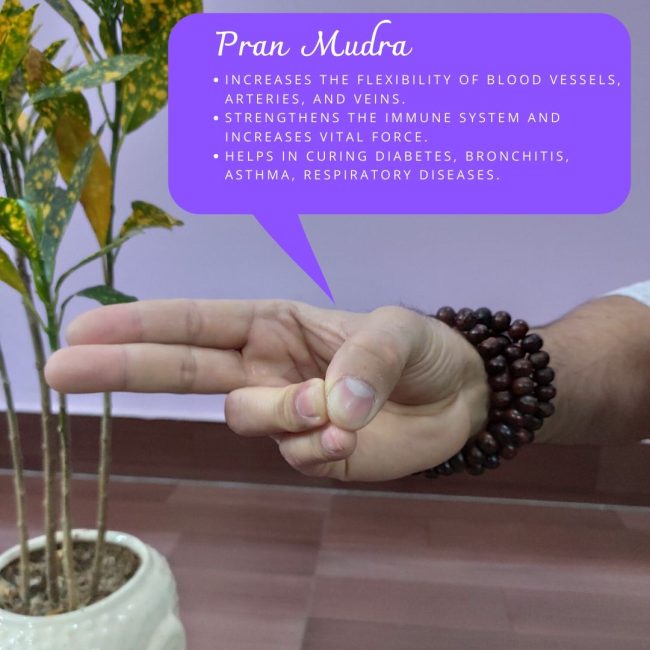
What are the Benefits of Pran Mudra?
1) Pran refers to the energy flow from the heart to the throat. Pran Mudra removes all imbalances and blockages in this region. It is good for the heart and lungs.
2) It increases the flexibility of blood vessels, arteries, and veins. It also removes the blockage from them allowing circulation of blood.
3) It strengthens the immune system and increases vital force.
4) Pran mudra is an excellent mudra for removing eye disease and improving eyesight.
5) It helps in curing diabetes, bronchitis, asthma, respiratory diseases.
6) It increases concentration and memory.
7) It rejuvenates the body and generates optimism.
8) This Mudra is very helpful in increasing willpower.
9) You can practice Pran mudra and Gyan mudra alternately to cure Insomnia.
Precautions & contraindications for Pran mudra?
Who should not Practice Pran mudra?
Women during their pregnancy or new mothers should avoid practicing Pran Mudra as it increases the heat in the body.
Do you want to learn the science of yoga mudras in depth? How to balance your inner energies? Join the coolest Ashtanga Yoga Teacher Training India course and transform your life. Overtake your stage fear and learn the skills and art of teaching Ashtanga Vinyasa, and Yin Yoga with confidence. Deepen your practice, and balance your Yin and Yang energies. Become A Certified 200 Hour Ashtanga Vinyasa Yin Yoga Teacher. Book Now!
Start your Yoga Journey to Transform your Life !
What is Apaan Mudra?
Apaan Mudra
This Mudra relates to Apaan Vayu (i.e. the energy flow from navel to feet). Apaan Mudra keeps this energy flow in a balance between these regions of the body.
This mudra affects all organs located in this part of the body. These organs are reproductive organs, stomach, colon, rectum, anus, hips, thighs, legs, knees, and feet.
Apaan Mudra is a combination of three elements i.e. fire, space, and earth. Apaan Mudra is a combination of two tattva mudras i.e Prithvi mudra and Akash mudra.
How to do Apaan Mudra?
How to Practice Apaan Mudra?
Sit in a padmasana (lotus pose) or any comfortable posture, with a straight back.
Now join the tips of the ring finger and middle finger with the tip of the thumb. Keep the other two fingers straight. Keep the back of your hand on the knees.
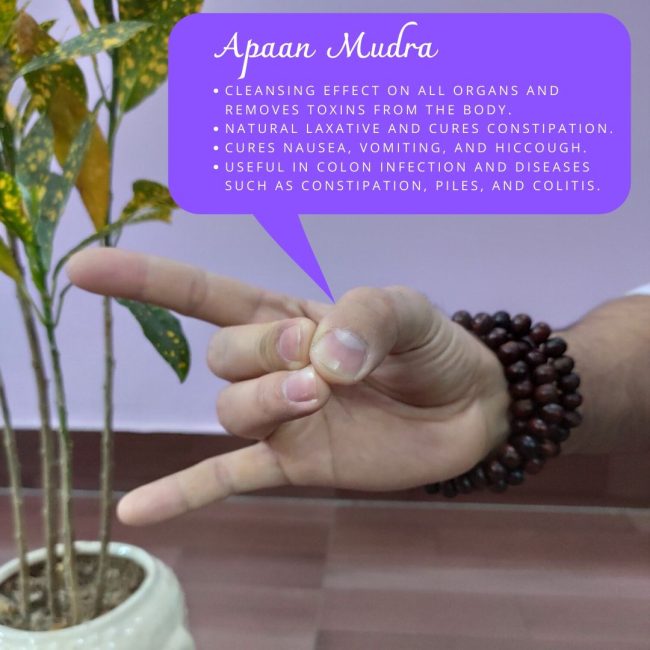
What are the Benefits of Apaan Mudra?
1) It has a cleansing effect on all organs and removes toxins from the body. You use apaan mudra as a detoxifier. It helps in getting rid of the free radicals (toxic waste) from the body.
2) It is a natural laxative and cures constipation.
3) Apaan mudra is good for stomach disorders such as diarrhoea and gastritis.
4) It cures nausea, vomiting, and hiccough.
5) This mudra is useful in urinary tract infections (UTI).
6) Apaan mudra is useful in colon infection and diseases such as constipation, Piles, and colitis, and gas.
7) This mudra cures the impotency of males and females.
8) Apaan mudra is good in menstrual problems such as irregularity of menses, pain, and cramps during menses.
9) Apaan mudra can help in activating the swadhisthan and mooladhaar chakras.
Precautions & contraindications for Apaan mudra ?
Who should not Practice Apaan mudra?
1) Females should avoid apaan mudra during pregnancy since this mudra will trigger the outward energy flow.
2) People suffering from severe digestion problems, or problems related to irritable bowel syndrome, inflammatory bowel syndrome should avoid apaan mudra
What is Vyan Mudra?
Vyan Mudra
Vyan Mudra controls and balances the Vyan Vayu i.e Vyan energy. Vyan energy flows in all parts of the body and it is related to the water element and swadhisthana Chakra. This Chakra is the source of creativity of body and mind.
Vyan Mudra is the union of space, air, and fire elements. Vyan mudra is a combination of Gyan mudra and Akash mudra. Both these mudras are tattva mudras.
How to do Vyan Mudra?
How to Practice Vyan Mudra?
To Practice Vyan Mudra, sit in a padmasana (lotus pose) or any comfortable posture, with a straight back. Now join the tips of the index finger and middle finger with the tip of the thumb. Keep the other two fingers straight. Keep the back of your hand on the knees.
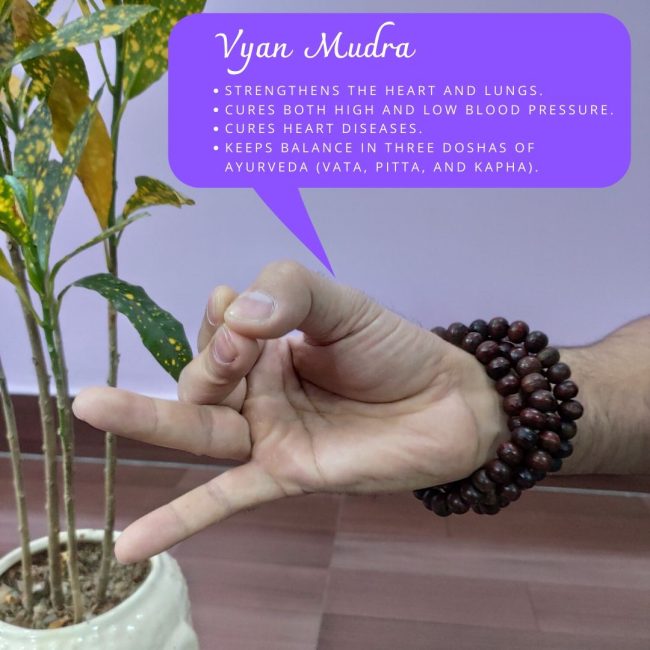
What are the Benefits of Vyan Mudra?
1) This Mudra brings the air and space elements in synergistic balance in the body. It strengthens the heart and lungs.
2) It cures both high and low blood pressure. To keep blood pressure in control, practice vyan mudra for 30 minutes twice a day.
3) It cures heart diseases.
4) Vyan Mudra ensures proper blood circulation in all parts of the body. Vyan Mudra stimulates the vyan Vayu responsible for all types of movements and the proper circulation of lymph and blood throughout the body. Thus it is responsible for distributing oxygen and nutrition to all the cells in the body through the circulatory system.
5) Vyan mudra is the master mudra for keeping balance in three doshas of Ayurveda i.e. Vaat, Pitta, and Kapha. Thus it keeps our body disease-free.
6) Vyan mudra also helps in removing drowsiness and excessive sleep. So if you are a lazy person, too much interested in sleeping then you must try vyan mudra.
What is Udaan Mudra?
Udaan Mudra
Udaan Mudra controls and balances the Udaan Vayu i.e Udaan energy flowing from throat to top of the head. It purifies and controls all the sensory organs of this region. Udaan Mudra is formed by the union of four elements i.e Fire, air, space, and earth.
Udaan mudra is a combination of Gyan mudra, Akash mudra, and Prithvi mudra. All these three mudras are tattva mudras.
How to do Udaan Mudra?
How to Practice Udaan Mudra?
To Practice Udaan Mudra, sit in a padmasana (lotus pose) or any comfortable posture, with a straight back. Now join the tips of the Index finger, middle finger, and ring finger with the tip of the thumb and keeping the little finger straight. Now place the back of your hand on your knees.
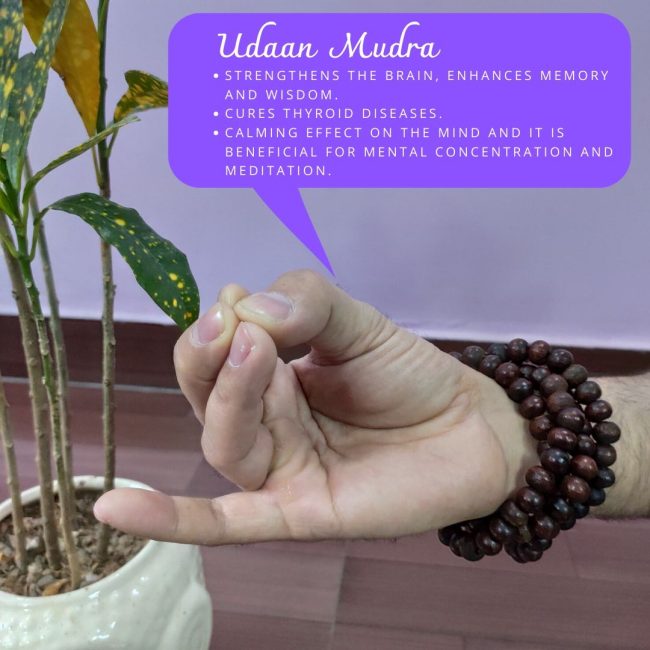
What are the Benefits of Udaan Mudra?
1) This Mudra strengthens the brain, enhances memory and wisdom.
2) Udaan mudra balances the udaan Vayu which in turn balances the thyroid gland, therefore, cures thyroid diseases.
3) Udaan Mudra has a calming effect on the mind and it is beneficial for mental concentration and meditation. In case if you are struggling with mental stress then you must practice Udaan mudra.
4) This Mudra affects the vishudhi chakra (Throat chakra).
What is Samaan Mudra?
Samaan Mudra
Samaan Mudra is the union of all the five elements i.e. space, air, earth, water, and fire. Samaan Vayu (Samaan energy) flows between the heart and the navel. It activates and controls the digestive system and its organs like the liver, intestines, pancreas and stomach, and their secretions.
Samaan Vayu is responsible for the assimilation and distribution of nutrients. On an evolutionary level, it relates to kundalini and the expansion of consciousness.
Samaan Mudra is the union of all the five elements i.e. space, air, earth, water, and fire. Samaan Mudra is a combination of four tattva mudras : Gyan mudra, Akash mudra, Prithvi mudra, and Indra mudra. Samaan Mudra is also known as mukal mudra or Samanvay mudra.
How to do Samaan Mudra?
How to Practice Samaan Mudra?
To Practice Samaan Mudra, sit in a padmasana (lotus pose) or any comfortable posture, with a straight back. Now join the tips of all four fingers with the tip of the thumb. Keep the back of your hand on the knees.
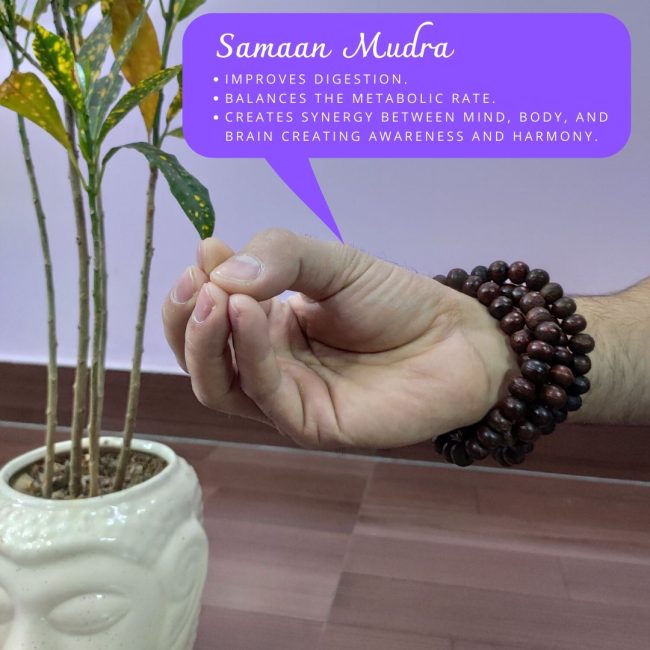
What are the Benefits of Samaan Mudra?
1) Samaan Mudra looks like a beak of a bird. Place this beak on any part of the body that is painful or weak. It helps to remove the pain or weakness in that particular part of the body.
2) Samaan Mudra improves digestion. Samaan Vayu is responsible for the assimilation and distribution of nutrients. It can also cure improper digestion, lack of appetite.
3) Samaan Mudra is highly beneficial in balancing the metabolic rate of the body. In case if you have a High or fast metabolic rate or slow metabolic rate then this Samaan Mudra helps in creating a balance.
4) Samaan Mudra helps to increase appetite. In case if you have a lack of appetite then you must try samaan mudra.
5) This mudra creates synergy between mind, body, and brain creating awareness and harmony.
Conclusion
I hope after reading this post you will add Pranik mudras in your daily routine. I hope you liked this post. Now I will like to hear from you. What did you think of today’s post?
Or maybe if you have a question about any of the pranik yoga mudras.
Let me know by leaving a comment below.
Do you want to learn yoga and share it through teaching to others? Searching for the best yoga school in India? You are in the right place!
Yoga Chaitanya International Institute is one of the leading Yoga Teacher Training schools in India. Our unique courses and programs give a transformational life-changing experience. Yoga Chaitanya offer different multi-style yoga teacher training programs.
They offer 200 Hour Multistyle Yin Yang Yoga Teacher Training. 200 Hour Yin Yoga & Meditation Teacher Training, and 200 Hour Yoga Therapy Teacher Training. Our teacher training enables you to explore a variety of yoga styles.
“Choose your Yoga Teacher Training”
Start your Yoga Journey & Transform your Life !

About the Author: Sukhvinder Singh Chaitanya
Sukhvinder Singh (Chaitanya) is an experienced yoga teacher. (ERYT-500 & YACEP with 20,000+ hours of teaching experience) He is a master yoga teacher in Ashtanga Vinyasa Yoga, Vinyasa Flow, Hatha Yoga, Yin Yoga, Iyengar Yoga, Ayurveda & Laughter Yoga. He has been teaching yoga, laughter yoga & meditation all across the globe in teacher training programs, workshops & corporate sector for almost 10 years. He's the founder and director of the Yoga Chaitanya International Institute, a leading Yoga Teacher Training school in the world. He shares his expertise in his blogs and his YouTube Channels.
